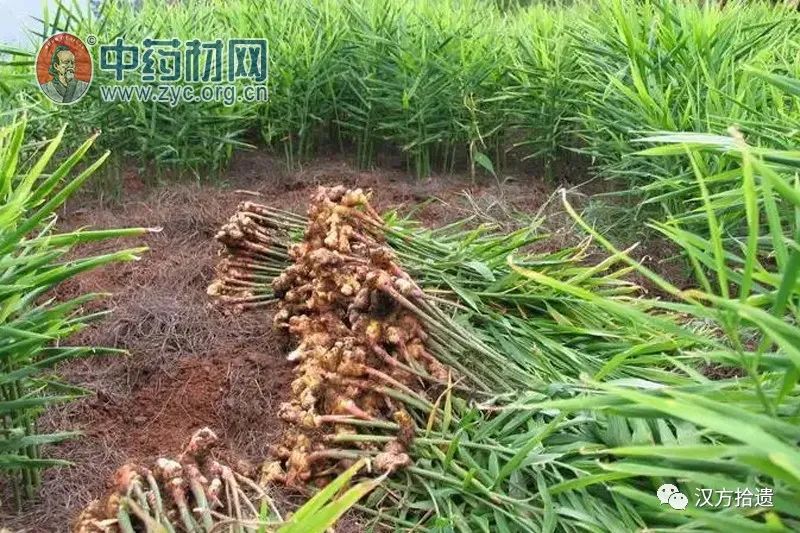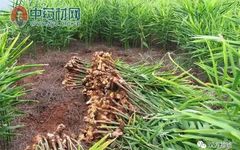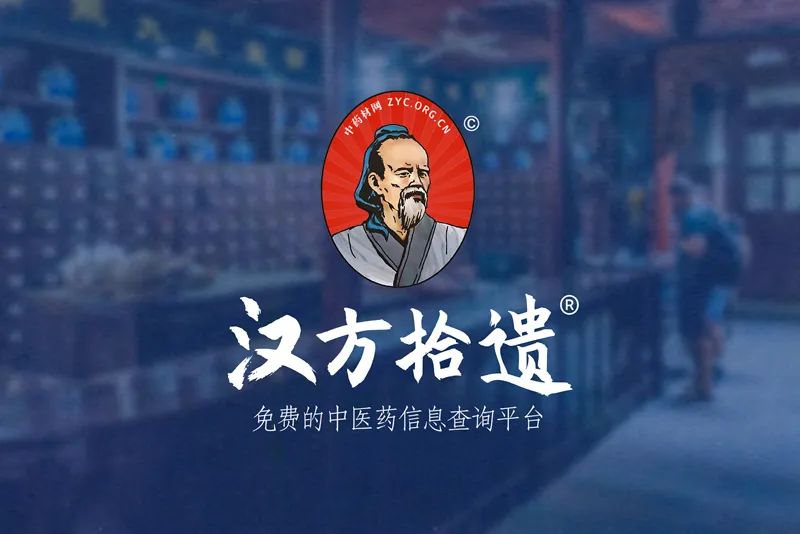“Dried ginger, known in traditional Chinese medicine (TCM) as Gan Jiang. Other names include Gan Sheng Jiang, Bai Jiang, and Jun Jiang. It is the dried rhizome of the plant Zingiber officinale Rosc. from the ginger family. It has the effects of warming the middle, dispersing cold, restoring yang, unblocking the meridians, warming the lungs, and transforming phlegm. It is primarily used to treat cold pain in the abdomen, vomiting, diarrhea, loss of yang leading to counterflow, cough due to cold phlegm, and cold dampness causing pain. It is classified as a warming interior medicine.”
Properties and Meridian Affinities
Nature: hot; Taste: pungent. It enters the spleen, stomach, heart, kidney, and lung meridians.

01
—
Functions and Actions
Functions
Warming the middle, dispersing cold, restoring yang, unblocking the meridians, warming the lungs, and transforming phlegm.
Indications
1. Cold syndrome of the spleen and stomach: Symptoms include cold pain in the abdomen, vomiting, diarrhea, etc. Dried ginger is pungent and hot, good at warming the middle and dispersing cold, assisting the yang qi of the spleen and stomach. Therefore, it can be used for both external cold invasion and internal cold due to deficiency of yang qi.
2. Yang collapse: Dried ginger is effective in eliminating internal cold and can also unblock the meridians to assist yang.
3. Cold phlegm obstructing the lungs: Symptoms include cough, wheezing, feeling cold in the back, and excessive clear phlegm. Dried ginger can warm and disperse lung cold and transform phlegm.
4. Cold dampness causing pain: This herb can also disperse cold, dry dampness, and unblock the meridians.
Dosage and Administration
Internal use: decoction, 3-10g; or in pills or powders.
External use: appropriate amount, decocted for washing; or ground into powder for topical application.
Contraindications
Contraindications in TCM compatibility:
1. Avoid with Huang Lian, Huang Qin, and Tian Shu Shi.
2. Avoid with Ban Xia and the toxic plant Lang Dang.
Precautions
Contraindicated for those with yin deficiency and internal heat, or blood heat causing erratic movement.
Chemical Composition
Contains about 2% volatile oil, with main components including gingerol, zingiberene, camphene, gingerone, and other compounds. Also contains resin, starch, and various amino acids.
Pharmacological Effects
Dried ginger has sedative, analgesic, anti-inflammatory, anticoagulant, and anti-hypoxic effects, influencing cardiovascular, adrenal cortex function, and the digestive system.
Toxicological Effects
Dried ginger has low toxicity, with the LD50 of its methanol extract in mice being 33.5g (raw herb)/kg. The LD50 of its ether extract in mice by gavage is 16.3ml/kg. The LD50 of its ethanol extract in mice by intravenous injection is 2.08g/kg.
Related Discussions
① “Ben Jing”: “It is used for chest fullness, cough, counterflow of qi, warming the middle, stopping bleeding, inducing sweating, expelling wind-dampness, and treating diarrhea. Fresh is especially good.”
② “Bie Lu”: “It treats cold abdominal pain, evil, cholera, fullness, wind evil toxins, and stops blood saliva.”
③ “Yao Xing Lun”: “It treats cold pain in the waist and kidneys, cold qi, breaks blood, expels wind, unblocks the four limbs, opens the five organs, expels wind toxins and cold dampness, and treats frequent urination at night. It is suitable for patients who are deficient and cold, and should be used more.”
④ “Tang Ben Cao”: “It treats wind, counterflow of qi, stops bleeding, unblocks the meridians, and induces slight sweating.”
⑤ “Ri Hua Zi Ben Cao”: “It transforms phlegm, counteracts qi, treats cramps, vomiting and diarrhea, cold in the abdomen, counterflow of qi, blood stasis, and stops excessive nasal discharge, resolves cold and heat toxins, opens the appetite, and transforms food stagnation.”
⑥ “Yi Xue Qi Yuan”: “The ‘Secret Essentials of Treatment’ states that it unblocks heart qi, assists yang, expels cold from the viscera, and treats cold abdominal pain.”
⑦ Wang Hao Gu: “It treats cold phlegm in the heart, and the eyes for a long time. It is processed to warm the spleen and dry the stomach.”
⑧ “Yi Xue Ru Men”: “Processed ginger warms the spleen and stomach, treats internal cold, diarrhea, and chronic malaria, cholera; cold pain and fullness in the heart and abdomen, stops nasal bleeding, blood saliva, blood diarrhea, and menorrhagia.”
⑨ “Yao Pin Hua Yi”: “Processed ginger expels virtual heat.”
⑩ “Chang Sha Yao Jie”: “It dries dampness, warms the middle, moves stagnation downward, calms cough, and stops diarrhea.”
02
—
Clinical Applications
Clinical Applications
1. Treats dry vomiting and counterflow of qi, with foamy saliva, combined with Ban Xia, to warm the middle, harmonize the stomach, and stop vomiting, as in the “Jin Gui Yao Lue” Ban Xia Gan Jiang San.
2. Treats cold pain in the abdomen due to spleen and stomach deficiency, vomiting, and diarrhea, combined with Dang Shen, Bai Zhu, and Zhi Gan Cao, to strengthen the spleen and benefit qi, warm the middle, and disperse cold, as in the “Shang Han Lun” Li Zhong Wan.
3. Treats limbs turning cold due to yang collapse, with weak pulse, often used with Fu Zi, which can enhance the effect of restoring yang and counterflow, while reducing the toxicity of Fu Zi, as in the “Shang Han Lun” Tong Mai Si Ni Tang, Gan Jiang Fu Zi Tang.
4. Treats cold phlegm obstructing the lungs, symptoms include cough, wheezing, feeling cold in the back, and excessive clear phlegm. Combined with Xi Xin and Ma Huang to enhance the medicinal power, as in the “Shang Han Lun” Xiao Qing Long Tang, “Jin Gui Yao Lue” Ling Gan Wu Wei Jiang Xin Tang.
5. Treats cold dampness causing pain, combined with Cang Zhu, Du Huo, and Wu Tou to enhance the effect of dispersing cold and eliminating dampness.
Related Combinations
1. Dried ginger combined with Ban Xia: Dried ginger warms the middle and disperses cold, transforms phlegm; Ban Xia harmonizes the stomach and stops vomiting. Together, they have the effect of dispersing cold and stopping vomiting, suitable for virtual cold vomiting.
2. Dried ginger combined with Hou Po: Dried ginger warms the middle and disperses cold, while Hou Po warms the middle and disperses cold, and also descends qi. Together, they have the effect of warming the middle, dispersing cold, and eliminating fullness, suitable for stomach distension and fullness due to cold phlegm.
3. Dried ginger combined with Bai Zhu: Dried ginger excels at warming the spleen and stomach and dispersing cold; Bai Zhu is good at strengthening the spleen and drying dampness. Together, they have the effect of dispersing cold and drying dampness, suitable for spleen and stomach deficiency with cold pain in the abdomen, vomiting, and diarrhea.
4. Dried ginger combined with Fu Zi: Dried ginger is very hot and non-toxic, effectively warming yang and restoring the middle, unblocking the meridians; Fu Zi is pure yang and hot, toxic, assisting heart yang to unblock the meridians, and tonifying kidney yang to benefit fire, known as the “first medicine for restoring yang and counterflow.” Together, they have a synergistic effect, and it is said that “without ginger, Fu Zi cannot generate heat,” and can also reduce the toxicity of Fu Zi.
5. Dried ginger combined with Xie Bai: Dried ginger warms the middle and disperses cold, restoring yang and unblocking the meridians; Xie Bai warms and unblocks heart yang, dispersing cold and moving stagnation. Together, they have the effect of warming and unblocking heart yang, dispersing cold, and unblocking the meridians, suitable for chest yang not thriving, yin cold congealing, qi stagnation, phlegm obstruction, chest tightness, and pain or accompanying wheezing and coughing.
Distinguishing Medicinal Uses
1. Dried ginger, processed ginger, and ginger carbon: Dried ginger is hot and slightly dry, primarily warming the middle, dispersing cold, restoring yang, and unblocking the meridians, especially suitable for cold evil in the middle jiao and cold phlegm obstructing the lungs. It is often used for cold pain in the abdomen, vomiting, diarrhea, cold limbs, weak pulse, and phlegm cough. Processed ginger is bitter and pungent, warm, its warming power is not as strong as dried ginger, but it has a milder and longer-lasting effect, suitable for treating abdominal pain, diarrhea, and bleeding due to cold in the middle jiao. Ginger carbon has lost its pungency, is non-toxic, and specializes in stopping bleeding and warming the meridians; its bitter and astringent properties are stronger than processed ginger, but its warming effect is not as strong, commonly used for various types of bleeding due to deficiency and cold.
2. Dried ginger and Fu Zi: Both herbs are pungent and hot, effective in restoring yang, dispersing cold, and stopping pain, treating yang collapse, spleen and kidney yang deficiency, or external cold directly affecting the body, and cold dampness causing pain. The difference is that Fu Zi is highly toxic and is the first choice for treating yang collapse; it also tonifies fire and assists yang, treating impotence due to deficiency of the fire of the life gate, cold in the uterus, frequent urination, and other conditions. Dried ginger is non-toxic and has a weaker effect, needing to be combined with Fu Zi for effectiveness; it excels at warming spleen yang, treating cold pain in the abdomen, vomiting, and diarrhea; it can also warm the lungs and transform phlegm, suitable for cough and wheezing due to cold phlegm.
3. Dried ginger and cinnamon: Both herbs are pungent and hot, entering the spleen and heart meridians, both can strengthen spleen yang, warm the middle, and disperse cold, used for cold in the middle jiao, spleen yang deficiency, cold pain in the abdomen, vomiting, and diarrhea. However, dried ginger is more pungent and warming, primarily entering the spleen and stomach meridians, while cinnamon also enters the kidney and liver meridians, tonifying fire and assisting yang, promoting blood circulation and unblocking the meridians, suitable for kidney yang deficiency, impotence, cold in the uterus, and other conditions.
4. Dried ginger and fresh ginger: Both dried and fresh ginger come from the same plant, both have the effect of warming the middle and dispersing cold, treating cold conditions. The difference is that fresh ginger is the fresh rhizome of the current year, with a milder effect, able to disperse wind-cold and treat mild colds, while also warming the middle, stopping vomiting, and treating cold in the stomach. Dried ginger is the dried rhizome of older ginger, known as old dried ginger, with a stronger effect, specializing in warming the middle, dispersing cold, restoring yang, and transforming phlegm, treating abdominal pain, vomiting, diarrhea, and cold limbs. Additionally, fresh ginger is traditionally believed to counteract the toxins of fish and crabs, as well as the raw Ban Xia and raw Nan Xing.
5. Dried ginger and Xi Xin: Both herbs are pungent and enter the lung meridian, both have the effect of warming the lungs and transforming phlegm, treating cough and wheezing due to cold phlegm. However, dried ginger is hot and dry, primarily entering the spleen and stomach meridians, while Xi Xin is warm and dry, also entering the kidney meridian, effective in dispelling wind, dispersing cold, and relieving pain, suitable for wind-cold exterior conditions, wind-cold headaches, nasal congestion, and tooth pain.
Related Medicinal Products
Shaoyang Cold Granules, Gastrointestinal Ning Tablets, Ding Chuan Paste, Jian Bu Pills.
Related Formulas
① For sudden heart pain: Dried ginger powder, warm wine, take a small spoonful, several times, will heal. (“Zhou Hou Fang”)
② For all cold conditions, qi stagnation, heart pain, chest and abdominal fullness: Four portions of white rice, add 30g each of dried ginger and good ginger, cook and eat. (“Shou Shi Qing Bian” Dried Ginger Porridge)
③ For post-meal sour vomiting: 60g each of dried ginger and Wu Zhu Yu. Prepare the two herbs, filter, and take a small spoonful with wine, twice daily. Effective for cold in the stomach. (“Qian Jin Yao Fang” Treating Middle Dispersal)
④ For pregnancy-related vomiting that does not stop: 30g each of dried ginger and Ren Shen, 60g of Ban Xia. Grind and form into pills the size of a walnut, take ten pills, three times a day. (“Jin Gui Yao Lue” Dried Ginger, Ginseng, and Ban Xia Pills)
⑤ For excessive diarrhea: Dried ginger powder, mixed with porridge, 3g, effective immediately. (“Zheng He Ben Cao” citing Sun Zhenren’s formula)
Dietary Therapy
Inner Gold Dried Ginger Lamb Soup:
1. Efficacy: Warms the middle, disperses cold, strengthens the spleen, and stops diarrhea. Used for chronic enteritis and chronic gastritis with spleen and stomach deficiency. Symptoms include cold pain in the abdomen, borborygmi, diarrhea with clear, watery stools several times a day, fatigue, and reduced appetite.
2. Ingredients: 250g lamb, 15g dried ginger, 12g chicken inner gold, 5 red dates.
3. Method: Clean the lamb and cut into pieces. Stir-fry in a hot pot to remove blood. Clean the dried ginger, chicken inner gold, and red dates (pitted), and add to the lamb in a clay pot with an appropriate amount of water. Boil over high heat, then simmer for 2 hours, season, and serve.
4. Usage: Consume with meals.

03
—
Processing and Preparation
Harvesting and Processing
Harvest before the frost in winter, remove stems, leaves, fibrous roots, and soil, wash clean, and dry or low-temperature dry.
Preparation Methods
Dried ginger: Remove impurities, soak in water for 3-6 hours, drain, steam, and then slice or cut into small cubes, and dry.
Processed ginger: Take ginger pieces, stir-fry in a pot over high heat until puffed and the outer skin turns dark yellow, and the inside turns yellow, spray with a little clean water, remove, and dry.
Storage Methods
Store in a dry container in a cool, ventilated place to prevent pests.
04
—
Identification of Medicinal Materials
Identification
1. The powder of this product is light yellow-brown. It contains numerous starch grains, which are long oval, triangular, elliptical, round, or irregular in shape, with a diameter of 5-40μm, with a small point at one end, and some may have cracks. The layer patterns are sometimes obvious. Oil cells and resin cells are scattered in the parenchyma, containing light yellow oil droplets or dark red-brown substances. Fibers are bundled or scattered, with blunt tips, some branched, and some may be wavy or serrated, with a diameter of 15-40μm, with slightly thick walls, non-lignified, with oblique fine pores, and often thin septa visible. Spiral vessels, reticulated vessels, and annular vessels are common, with a few being ring vessels, with a diameter of 15-70μm. Tubular cells containing dark red-brown substances may sometimes be seen near the vessels or fibers, with a diameter of 12-20μm.
2. Take 1g of this product powder, add 20ml of ethyl acetate, and sonicate for 10 minutes, filter, and take the filtrate as the test solution. Take 1g of dried ginger as a control herb and prepare the control solution in the same way. Then take 6-gingerol as a reference substance, dissolve in ethyl acetate to prepare a solution containing 0.5mg per 1ml, as the reference solution. Perform thin-layer chromatography (General Rule 0502), applying 6μl of each of the three solutions on the same silica gel G thin-layer plate, using petroleum ether (60-90℃)-chloroform-ethyl acetate (2:1:1) as the developing agent, develop, remove, dry, and spray with vanillin-sulfuric acid reagent, and heat at 105℃ until the spots are clearly colored. In the test solution, corresponding to the control herb and reference substance, spots of the same color should appear.
Differences Between Gao Liang Jiang and Dried Ginger
The differences between Gao Liang Jiang and dried ginger lie in the different plants, different effects, and different culinary effects. Gao Liang Jiang is the dried rhizome of the plant Gao Liang Jiang from the ginger family; while dried ginger is the dried rhizome of the plant ginger from the ginger family.
1. Different plant species: Gao Liang Jiang is the dried rhizome of the Gao Liang Jiang plant, which is tall, but the ginger is smaller, with a stronger and less mild flavor. Dried ginger is the dried rhizome of the ginger plant, which is older ginger that has been dried or low-temperature dried.
2. Different effects: Gao Liang Jiang is more focused on warming the interior, suitable for treating various symptoms caused by stomach cold, such as cold stomach pain, cold qi stagnation, and acid reflux. Dried ginger is more focused on tonifying yang, capable of warming the middle, dispersing cold, warming the lungs, transforming phlegm, and restoring yang, suitable for those with cold phlegm cough, cold pain in the abdomen, cold limbs, vomiting, and diarrhea, treating spleen and stomach deficiency, cold limbs, and cough.
3. Different culinary effects: Gao Liang Jiang is hot in nature and should be used when immediate effects are needed. However, Gao Liang Jiang does not nourish the body and can easily harm the stomach if used excessively. Dried ginger, after processing, has a stronger medicinal property than Gao Liang Jiang, and enters the spleen, stomach, kidney, heart, and lung meridians, its heat can circulate through the five organs, thus expelling internal cold, but should not be used excessively. If patients have yin deficiency, stomach fire causing vomiting, etc., they should avoid Gao Liang Jiang, and it is not suitable for long-term consumption to avoid gastrointestinal discomfort. Patients during menstruation, with yin deficiency and excess fire, those preparing for pregnancy, or pregnant women should avoid dried ginger.
Properties of Medicinal Materials
The bulb is round and slightly flattened, with a diameter of up to 3 cm and a thickness of about 2.5 cm, varying in size, with a central depression at the bottom, and several clusters of tender buds at the top, covered by withered yellow scales. The outer skin is purple-brown or black-brown, with obvious joints, and often has yellow-brown membranous scales remaining at the joints, sometimes with small lateral buds. The texture is brittle, the inside is white, rich in starch and moisture, and when crushed, it exudes a white milky juice. It has a faint aroma and a sweet taste. The best quality is large and plump. It is produced in most regions of China.
Properties of Slices
Irregular thick slices or blocks, with a surface that is yellow-white or gray-white, with obvious light yellow veins, showing a powdery or granular texture, with gray-brown or light yellow-brown edges, rough texture. The texture is hard and brittle. It has a unique aroma and a pungent taste.
05
—
Botanical Information
Plant Species
Ginger from the ginger family.
Morphological Characteristics
Perennial herb, 50-80cm tall. The rhizome is thick, with a yellow-white cross-section, and has a strong pungent aroma. Leaves are alternate, arranged in two rows, without petioles, nearly embracing the stem; leaf tongue is 2-4mm long; leaf blades are lanceolate to linear-lanceolate, 15-30cm long, 1.5-2.2cm wide, tapering to a point, with a narrow base, leaf sheath embracing the stem, hairless. Flower stalks emerge from the rhizome, 15-25cm long; spike-like inflorescences are oval, 4-5cm long; bracts are ovate, about 2.5cm long, light green, with light yellow edges, and a small pointed tip; the calyx tube is about 1cm long, with 3 short pointed teeth; the corolla is yellow-green, the tube is 2-2.5cm long, with 3 lobes, lanceolate, less than 2cm long, the middle lobe of the lip is long oval, shorter than the corolla lobes, with purple stripes and light yellow spots, the lateral lobes are ovate, yellow-green, with purple edges; there is 1 stamen, dark purple, the anther is about 9mm long, and the connective tissue wraps around the style; the ovary has 3 chambers, hairless, with 1 style and a nearly spherical stigma. The fruit is a capsule. The seeds are numerous and black. Flowering period is in August.
Distribution Areas
Cultivated in central, southeastern, and southwestern provinces of China.
Production Areas
Mainly produced in Hubei, Guangdong, Guangxi, Fujian, and Guizhou.
Growth Conditions
Prefers warm and humid climates, is not cold-resistant, sensitive to humidity, and direct sunlight. Avoid continuous cropping. It is best to choose sloped and slightly shaded areas for cultivation, with deep, loose, fertile, and well-drained sandy loam to heavy loam.
Propagation Methods
Propagated by rhizomes (seed ginger), either by hole planting or row planting.
Cultivation Techniques
Rhizome (seed ginger) propagation: In autumn, when harvesting fresh ginger, select thick, light yellow, shiny, disease-free rhizomes as seed ginger, store in a cellar or layer with fine sand indoors for storage. In the south, from January to April, and in the north, in May, take out the seed ginger, warm it to promote sprouting, then cut the seed ginger into small pieces, each with 1-2 strong buds. For hole planting, open holes with a spacing of 40cm×30cm, 13-17cm deep, first irrigate with manure water, wait for it to seep into the soil, then lay one piece of seed ginger flat in each hole, finally cover with fine compost and soil. For row planting, open trenches with a spacing of 40cm, apply base fertilizer, then plant with a spacing of 27cm, covering with soil level with the ground (in Sichuan, attention is paid to the depth of sowing, with deep sowing requiring about 30cm, and shallow sowing requiring 5-10cm for medicinal ginger).
Pest and Disease Control
1. Diseases include rot disease, commonly known as ginger plague, which is prone to occur in high temperatures and rainy seasons. Use Bordeaux mixture to soak seeds for 10 minutes, and remove diseased plants during outbreaks, using lime to disinfect the affected areas.
2. Pests include the Asian corn borer, which damages the ginger stalks in August and September. Use 90% dichlorvos diluted 1000 times to irrigate the leaves. The ginger butterfly, with larvae damaging the leaves, can be controlled with 80% dichlorvos diluted 1500 times.
|
Special Note: The above content is sourced from the internet, pharmaceutical monographs, magazines, and abstracts, and does not represent the views of Han Fang Shi Yi WeChat subscription platform/Chinese Medicinal Materials Network, nor does it verify the authenticity of the content. We do not guarantee its scientificity or seriousness in any form. The above content is for reading and reference only and should not be used as a basis for diagnosis. Any other media, networks, or individuals downloading and using content from this website shall bear legal responsibility for copyright and other legal issues. |

|
|
| > About Han Fang Shi Yi |
|
Han Fang Shi Yi (WeChat ID: zycorgcn) is a free TCM health preservation guide. The Chinese Medicinal Materials Network (website: zyc.org.cn) is a linked platform providing convenient and comprehensive TCM information query services, sharing classic TCM works, health culture, and the development of TCM, dedicated to promoting the essence of Chinese medicine. Welcome to subscribe for free! |
|
|
| > Copyright and Disclaimer |
|
① All content markedHan Fang Shi Yi (WeChat ID: zycorgcn) original content, copyright belongs to this subscription number, and reprints must retain this copyright statement. ② The content or services provided by the Han Fang Shi Yi subscription number are for personal study, research, or reference, and for other non-commercial or non-profit uses, we will strictly adhere to the provisions of the Copyright Law in creating/publishing/reprinting related content. ③ If this subscription number infringes your legitimate rights and interests, and the work of a natural person is still under protection, please contact us and provide proof materials, and we will handle it within three working days. |



